Issue 02/2019
Highlights: Thermoforming Building & Construction Basics: Biobased Packaging
Highlights:
Thermoforming
Building & Construction
Basics: Biobased Packaging
Create successful ePaper yourself
Turn your PDF publications into a flip-book with our unique Google optimized e-Paper software.
Plastics, made by nature, for cosmetics packaging<br />
10 Years ago<br />
10<br />
Years ago<br />
Cosmetics Pen made of Bio-Flex F 6510<br />
Beautiful Plastics Made by Nature<br />
Just a few cosmetics can be found in pure powder form. A lot of<br />
cosmetics are a mixture of chemical substances held in aqueous<br />
solutions or alcohol-based solvents. So, resistance and a high barrier<br />
against water and alcohol are often basic requirements for any plastics<br />
used in cosmetics packaging.<br />
Polylactic acid (PLA) and cellulose acetate (CA) are often chosen as<br />
raw biopolymers for bioplastics. PLA and CA are described as resistant<br />
to fats, water and alcohol [2], but both exhibit only a poor barrier against<br />
moisture vapour and alcohol. Furthermore, CA is described as resistant<br />
to weak acids.<br />
Beauty & Healthcare<br />
Jar 3 made of Bio-Flex V 1410<br />
Published in<br />
bioplastics<br />
MAGAZINE<br />
FKuR´s trade name Bio-Flex ® covers copolyester blends based on<br />
PLA which – depending on the respective grade – are composed of<br />
almost 100% natural resources. Bio-Flex does not contain any starch<br />
or starch derivatives. Bioplastics mostly replace conventional materials,<br />
i.e. polyethylene of low density (LDPE) and of high density (HDPE) as well<br />
as polystyrene (PS), polypropylene (PP) and polyethylene terephthalate<br />
(PET).<br />
Biograde ® is based on cellulose, a product of the paper industry,<br />
and has been specially designed for injection moulding applications.<br />
Biograde is predominantly obtained from natural resources (European<br />
soft wood from sustainable forestry). It does not contain starch or starch<br />
derivatives, and has an excellent heat resistance up to 122 °C. It can be<br />
transparent – depending on the grade – and is food contact approved.<br />
Under the brand name Fibrolon ® , FKuR develops natural fibre reinforced<br />
compounds (Wood/Plastic Composites: WPC), which, unlike many other<br />
WPCs, can be injection moulded without problems. Fibrolon compounds<br />
are characterised by high strengths and stiffness comparable to wood.<br />
Fibrolon F 8530 is a biodegradable compound on the basis of polylactic<br />
acid (PLA) and other compostable biopolymers. The content of natural<br />
resources is almost 100%.<br />
Bottle 2 made of Bio-Flex F 6510<br />
(J. Sieben)<br />
Beauty & Healthcare<br />
Little dish made of Fibrolon F 8530<br />
The applications described emphasise that Bio-Flex, Biograde<br />
and Fibrolon can be easily processed on standard injection moulding,<br />
blow moulding or extrusion machines. Biograde´s resistance, even to<br />
aggressive isododecane (a hydrocarbon ingredient used as a solvent in a<br />
number of cosmetic products) opens the wide field of colour cosmetics<br />
applications, however the barrier properties of all bioplastics really need<br />
to be improved.<br />
Eyeliner Pencil made of Biograde C 7500 CL<br />
[1] Cosmoprof study in co-operation with Formes<br />
de Luxe (2005)<br />
[2] Endres, H.-J., Siebert-Raths, A., Technische<br />
Biopolymere. Hanser Publishers (2009)<br />
www.fkur.com<br />
Beautiful Plastics Made by Nature<br />
bioplastics MAGAZINE [<strong>02</strong>/09] Vol. 4 11<br />
Article contributed by<br />
Dr. Christian Bonten<br />
Director of Technology and Marketing<br />
FKuR Kunststoff gmbH<br />
Willich germany<br />
Pad bag made of<br />
Bio-Flex F 1130<br />
Cosmetic Pens made of Fibrolon F 8530<br />
B<br />
eauty, and our constant efforts to achieve it, are an expression of<br />
luxury. And this expression is reflected not only in the contents<br />
but also in the packaging. Cosmetics and bodycare are a broad<br />
field of applications and a systematic approach is necessary. Let us divide<br />
the field of cosmetics applications into the following groups:<br />
• Hair Care (hairspray, shampoo, hair colorants, conditioner, curling<br />
aids)<br />
• Colour Cosmetics (lipsticks, eye cosmetics, nail cosmetics, make-up)<br />
• Bath and Shower (bath and shower soaps and syndets)<br />
• Deodorants and anti-perspirants,<br />
• Men´s grooming (razors and shavers, shaving foam and gel, aftershave)<br />
• Oral hygiene (toothpaste, tooth brushes, mouth wash, products for<br />
dentures)<br />
• Fragrances (perfumes, EDTs)<br />
• Skin Care (facial care, body lotion and powder, sun protection, hand<br />
and nail creme, depilatories)<br />
There are a number of major trends in the cosmetics industry [1].<br />
The population in the developed countries of the world is getting older.<br />
This will drive the demand for skin care and premium colour cosmetics.<br />
Furthermore, young girls (8-12 years) increasingly use cosmetics and<br />
their parents help choose them together with the girls. This will lead<br />
to more colourful and striking packaging with more unusual shapes.<br />
Another trend is that teenagers have their own money to buy cosmetics,<br />
but their limited budgets mean that they have to buy mass market<br />
products in retail stores. The fourth trend is that men increasingly use<br />
cosmetics, so premium men‘s cosmetics will grow more strongly.<br />
It is obvious that, in all of the above-mentioned groups of applications,<br />
the requirements placed on plastics are very different. But if plastics are<br />
used as packaging, the requirements become clear and manageable.<br />
Cosmetics packaging producers often ask for availability, processability on<br />
standard machines (extrusion or injection moulding, printing, assembly),<br />
chemical resistance to the cosmetic product, a barrier against the carrier<br />
solution (often water or alcohol), mechanical properties (tensile strength<br />
and impact strength, stiffness), aesthetic appearance (surface quality,<br />
printability etc.).<br />
tinyurl.com/2009cosmetic<br />
48 bioplastics MAGAZINE [<strong>02</strong>/19] Vol. 14<br />
10 bioplastics MAGAZINE [<strong>02</strong>/09] Vol. 4


















